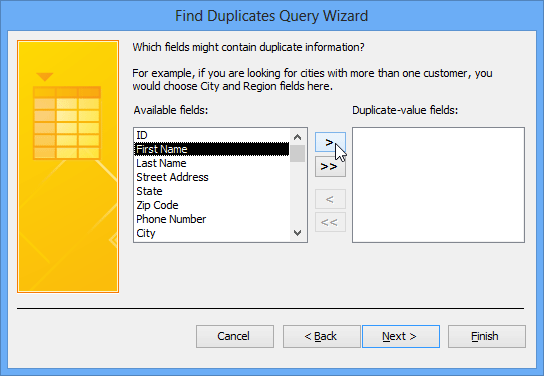How To Find Duplicates Query In Microsoft Access 2013
Find duplicates query allows you to search for and identify duplicate records within a table or tables. A duplicate record is a record that refers to the same thing or person as another record.
Not all records containing comparable data are copies. For example, records of two requests that were put on various dates yet that contained indistinguishable things would not be copy records. In like manner, not every copy record contain totally indistinguishable data. For instance, two client records could allude to a similar individual yet incorporate distinctive locations. The record with the obsolete address would be the copy record.
Why is disposing of copy records so essential? Consider the case above. In the event that we had different records for one client, it is hard to see a request history for him on the grounds that the data would be spread over a few unlinked records. We may considerably convey his request to the wrong address if the individual entering the request data chooses an obsolete record. It's anything but difficult to perceive how having copy records can undermine the trustworthiness and helpfulness of your database.
Luckily, Access makes it simple to look for and find potential copy records. Note that Access won't erase the records for you or enable you to make sense of which one is present—you'll need to do those things for yourself. In case you're acquainted with the information in your database, however, disposing of copy records will be a reasonable assignment.
To make a discover copies question:
- Select the Create tab on the Ribbon, find the Queries gathering, and tap the Query Wizard summon.

- The New Query exchange box will show up. Select Find Duplicates Query Wizard from the rundown of inquiries, at that point click OK.

- Select the table you need to look for copy records, at that point click Next. We're looking for copy client records, so we'll choose the Customers table.

- Pick the fields you need to scan for copy data by choosing them and after that tapping the correct bolt catch. Just select fields that ought not be indistinguishable in nonduplicate records. For example, since we're looking for copy clients we'll just choose the First Name and Last Name fields since it's improbable that numerous individuals with precisely the same and last names would put orders at our bread shop.
- When you've included the coveted fields, click Next.

- Select extra fields to see in the question comes about. Pick handle that will enable you to recognize the copy records, and pick which one you need to keep. In our case, we'll include the greater part of the fields identifying with client addresses, in addition to the Phone Number field since records with indistinguishable client names may contain nonidentical data in this field. When you're fulfilled, click Next.

- Access will recommend a name for your inquiry, however you can type an alternate name in the event that you need. When you're happy with the inquiry name, click Finish to run your question.

On the off chance that Access found any copy records in your inquiry, they will be shown in the question comes about. Audit the records and erase any obsolete or off base records as required.
For More Recommended Articles Visit www.office.com/setup